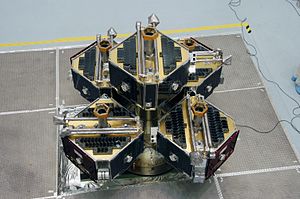
Back THEMIS BS THEMIS Czech THEMIS German THEMIS Spanish THEMIS Finnish Time History of Events and Macroscale Interactions during Substorms French THEMIS Galician תמיס (סדרת לוויינים) HE THEMIS Croatian THEMIS műholdak Hungarian
 Five THEMIS satellites | |
| Names |
|
|---|---|
| Mission type | Magnetospheric research |
| Operator | NASA |
| COSPAR ID | 2007-004 (A, B, C, D, E) |
| SATCAT no. | 30580, 30581, 30582, 30583, 30584 |
| Website | http://themis.igpp.ucla.edu/ |
| Mission duration | Planned: 2 years Elapsed: 17 years, 3 months and 11 days |
| Spacecraft properties | |
| Spacecraft | Explorer LXXXV |
| Spacecraft type | Time History of Events and Macroscale Interactions during Substorms |
| Bus | THEMIS |
| Manufacturer | Swales Aerospace |
| Launch mass | 126 kg (each)[1] |
| Power | 37 watts (each) |
| Start of mission | |
| Launch date | 17 February 2007, 23:01:00 UTC |
| Rocket | Delta II 7925-10C (Delta 323) |
| Launch site | Cape Canaveral, SLC-17B |
| Contractor | Boeing Defense, Space & Security |
| Entered service | 4 December 2007 |
| Orbital parameters | |
| Reference system | Geocentric orbit[2] |
| Regime | Highly Elliptical Orbit |
| Perigee altitude | 470 km (290 mi) |
| Apogee altitude | 87,330 km (54,260 mi) |
| Inclination | 16.00° |
| Period | 1870.00 minutes |
| Instruments | |
| Electric Field Instruments (EFI) Electrostatic Analyzer (ESA) Fluxgate magnetometer (FGM) Search-coil magnetometer (SCM) Solid State Telescope (SST) | |
 THEMIS mission patch Explorer program | |
Time History of Events and Macroscale Interactions during Substorms (THEMIS) mission began in February 2007 as a constellation of five NASA satellites (THEMIS-A through THEMIS-E) to study energy releases from Earth's magnetosphere known as substorms, magnetic phenomena that intensify auroras near Earth's poles. The name of the mission is an acronym alluding to the Titan Themis.[3]
Three of the satellites orbit the Earth within the magnetosphere, while two have been moved into orbit around the Moon. Those two were renamed ARTEMIS for Acceleration, Reconnection, Turbulence and Electrodynamics of the Moon's Interaction with the Sun. THEMIS-B became ARTEMIS-P1 and THEMIS-C became ARTEMIS-P2.[4] ARTEMIS-P1 and -P2 together comprise the THEMIS-ARTEMIS mission.[5]
The THEMIS satellites were launched 17 February 2007 from SLC-17B aboard a Delta II launch vehicle.[3][6] Each satellite carries five identical instruments, including a fluxgate magnetometer (FGM), an electrostatic analyzer (ESA), a solid state telescope (SST), a search-coil magnetometer (SCM) and an electric field instrument (EFI). Each probe has a mass of 126 kg (278 lb), including 49 kg (108 lb) of hydrazine fuel.[7]
THEMIS data can be accessed using the SPEDAS software. Canada, Austria, Germany, and France also contributed to the mission.
- ^ "ARTEMIS (THEMIS)". NASA's Solar System Exploration website. Retrieved 29 November 2022.
- ^ "Trajectory: THEMIS-A (Explorer 85) 2007-004A". NASA. 28 October 2021. Retrieved 5 December 2021.
 This article incorporates text from this source, which is in the public domain.
This article incorporates text from this source, which is in the public domain.
- ^ a b "THEMIS (Explorer 85)". NASA. 28 October 2021. Retrieved 4 December 2021.
 This article incorporates text from this source, which is in the public domain.
This article incorporates text from this source, which is in the public domain.
- ^ Phillips, Tony. "Dead Spacecraft Walking". ARTEMIS mission site. NASA. Retrieved 28 June 2011.
 This article incorporates text from this source, which is in the public domain.
This article incorporates text from this source, which is in the public domain.
- ^ Johnson-Groh, Mara (7 October 2019). "Artemis, meet ARTEMIS: Pursuing Sun Science at the Moon". NASA. Retrieved 10 October 2019.
 This article incorporates text from this source, which is in the public domain.
This article incorporates text from this source, which is in the public domain.
- ^ Justin Ray (18 February 2007). "Mission Status Center: THEMIS". SpaceFlight Now. Retrieved 2 December 2009.
- ^ "SPACEWARN Bulletin, No. 640". NASA. 1 March 2007. Retrieved 2 December 2009.
 This article incorporates text from this source, which is in the public domain.
This article incorporates text from this source, which is in the public domain.
© MMXXIII Rich X Search. We shall prevail. All rights reserved. Rich X Search